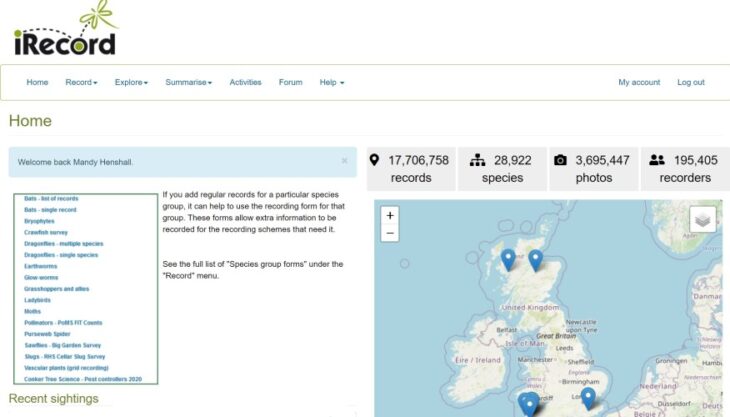Written by Martin Harvey, UKCEH Biological Records Centre
During 2021 over 2 million records were added to iRecord and shared from the apps and websites that make use of the iRecord data warehouse – this is the second year in a row with an annual total of over 2 million records. Thanks to all who have contributed and to all the recording scheme verifiers who are working hard on checking the records so that they can be shared with the NBN Atlas. Nearly 60% of the records from 2021 have been verified already, and this proportion will rise as recording schemes catch up over the coming months.
Just before Christmas 2021 the iRecord development team upgraded the website to implement the latest version of the Drupal software that supports the site, as part of our ongoing commitment to maintain the site and enable new features to be added.

Links with iNaturalistUK
The 2 million total for 2021 includes over 350,000 records that were added to iNaturalistUK and imported into iRecord, as part of the recent iNaturalistUK project that is being led by the NBN Trust, Marine Biological Association and Biological Records Centre. The iNaturalist records are now starting to be included in the record uploads to the NBN Atlas from iRecord, making the records more widely available alongside the other contributors to the bigger picture on the NBN Atlas.
UK records get imported to iRecord once they reach “research grade” status on iNaturalist. During the import process the iNaturalist species names are matched to the UK Species Inventory, and UK grid references are added alongside the original lat/long coordinates used in iNaturalist. The iNaturalist records will be included in the downloads available to recording schemes and records centres. More information about the iNaturalistUK project is available on the NBN website.
How iNaturalist users can help iRecord verifiers
There are a number of steps that iNaturalist users can take if they wish to make their records as compatible as possible with the UK recording schemes:
- Choose an open licence for your records: CC0 or CC BY will enable your records to be used as widely as possible; CC BY-NC (non-commercial) can prevent records being used by some schemes and records centres. Other licence choices (such as SA and ND) are difficult to interpret for individual records, and cannot be used in iRecord or the NBN Atlas (nor on GBIF). More info is on the iNaturalistUK blog.
- Provide your real name if possible; this can be added as the “Display name” in your iNaturalist profile, and will then be used as the recorder name on iRecord
- Avoid obscuring locations unless absolutely necessary, as this can prevent them being linked to grid references of suitable precision for recording scheme use
- Now that the record import is in place, it is helpful if you can avoid adding the same record to both iNaturalist and iRecord, to avoid duplication of both records and of verifiers’ time.
Exchange of records with the BirdTrack online recording system?
BirdTrack (the online recording system that is provided by the British Trust for Ornithology and partners) is the main tool for bird recording in the UK, but you may not realise that for some time now BirdTrack has included options for recording some additional species groups, as well as birds.?
BRC has been working with BTO to develop a two-way exchange process, so that bird records added to iRecord can be shared with BirdTrack and verified at the BirdTrack end, while non-bird records from BirdTrack can be shared with iRecord for verification there.
This has been a complex piece of work but it is almost ready to go live, and we expect that it will be in place later in January. The majority of records that will come through to iRecord initially will be of mammals and dragonflies/damselflies, which have been a part of BirdTrack for some years. From July 2021 coverage was extended to include butterflies, amphibians, reptiles and orchids as well. For more information see the BTO news page.?
Verification and data sharing
It is extremely encouraging to see increasing numbers of records and recorders contributing to wildlife recording in the UK. This increase also places additional demands on the verifiers who volunteer their time to check the records, and BRC is enormously grateful to the people who contribute to this process.
As a result of all this activity, more records are flowing more quickly to the national schemes, local records centres and the NBN Atlas. Records are shared on behalf of the national recording schemes who check them, and currently over 2 million records are updated onto the NBN Atlas every month or two via iRecord’s direct export system, with an estimated 8 million further records routed through the schemes themselves to the NBN Atlas. For more information see the iRecord/NBN Atlas data sharing page.
iRecord is maintained and developed by the UKCEH Biological Records Centre (BRC). iRecord and the related Indicia systems provide online tools to collate records for checking and sharing.
